Organisations and Management Essay: Corporate Social Responsibility
VerifiedAdded on 2023/06/08
|7
|2419
|114
Essay
AI Summary
This essay provides an analysis of the article "The Truth About CSR" by Rangan, Chase, and Karim (2015). The essay begins by summarizing the authors' main argument, which focuses on companies' CSR activities and their impact on profitability and societal well-being. It then explores the authors' research methodology, including their survey of managers, and discusses the limitations of the study, such as the sample bias towards larger organizations and the potential lack of CEO involvement in CSR programs in some companies. The essay further examines the authors' findings, including the idea that CSR programs should be tailored to the specific industry and societal context. The essay also discusses the concept of shared value and the alignment of CSR programs with business objectives. A case study of Starbucks is included to demonstrate how a company can integrate CSR into its business model. The essay also includes a review of relevant articles, and direct and indirect quotes from the articles to support the analysis.
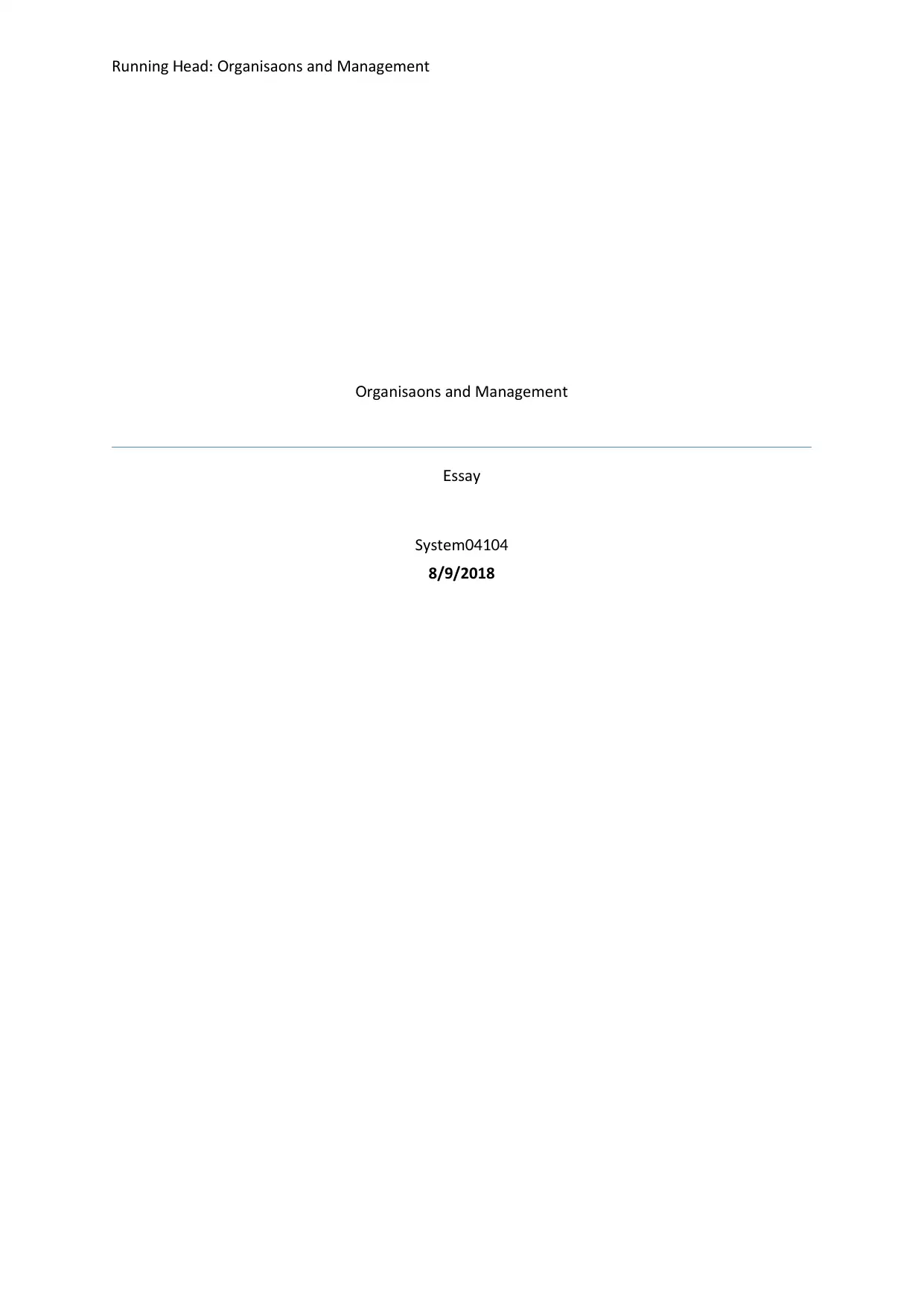
Running ead rganisations and ManagementH : O
rganisations and ManagementO
ssayE
System04104
8/9/2018
rganisations and ManagementO
ssayE
System04104
8/9/2018
Paraphrase This Document
Need a fresh take? Get an instant paraphrase of this document with our AI Paraphraser
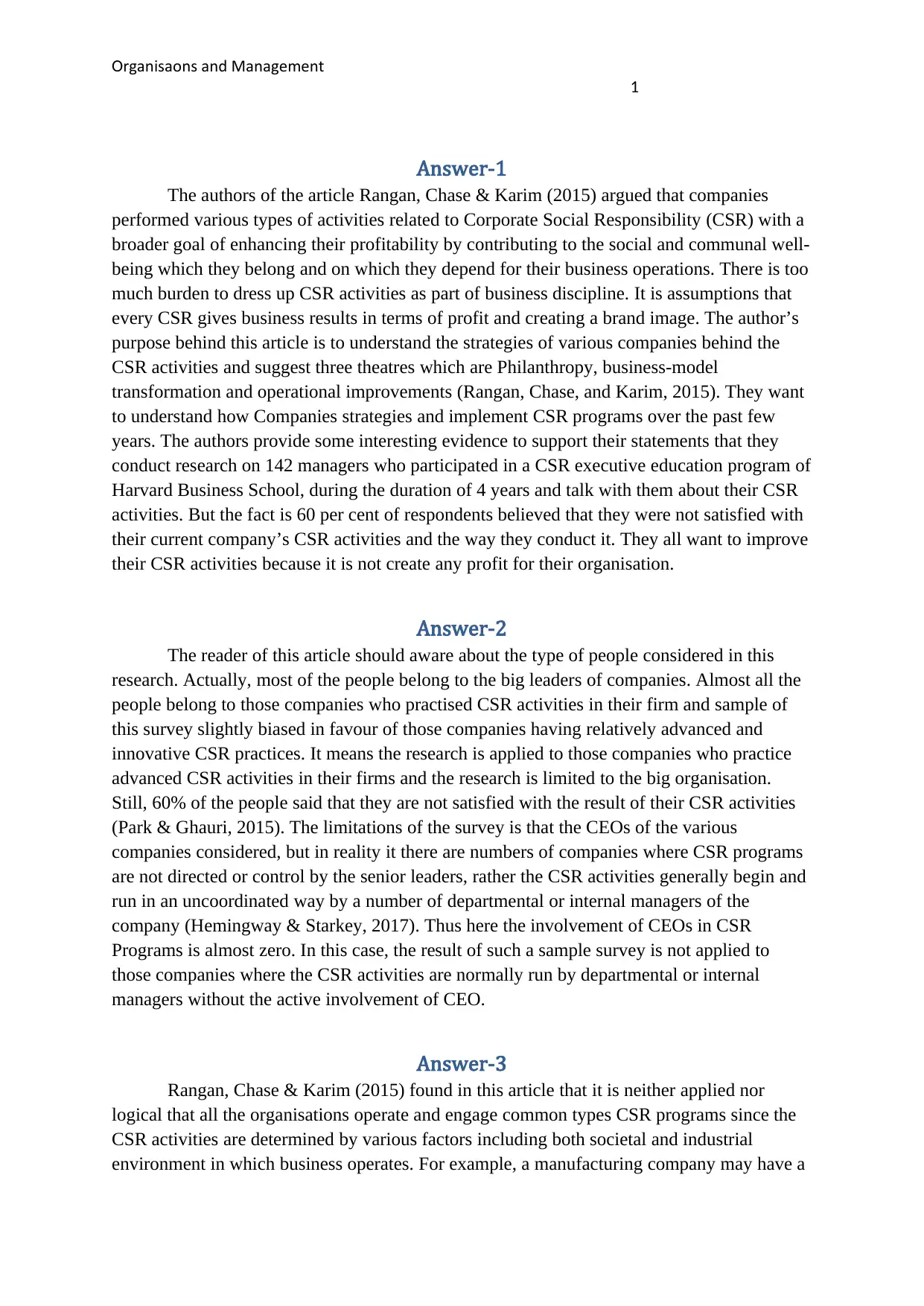
rganisations and ManagementO
1
Answer-1
The authors of the article Rangan, Chase & Karim (2015) argued that companies
performed various types of activities related to Corporate Social Responsibility (CSR) with a
broader goal of enhancing their profitability by contributing to the social and communal well-
being which they belong and on which they depend for their business operations. There is too
much burden to dress up CSR activities as part of business discipline. It is assumptions that
every CSR gives business results in terms of profit and creating a brand image. The author’s
purpose behind this article is to understand the strategies of various companies behind the
CSR activities and suggest three theatres which are Philanthropy, business-model
transformation and operational improvements (Rangan, Chase, and Karim, 2015). They want
to understand how Companies strategies and implement CSR programs over the past few
years. The authors provide some interesting evidence to support their statements that they
conduct research on 142 managers who participated in a CSR executive education program of
Harvard Business School, during the duration of 4 years and talk with them about their CSR
activities. But the fact is 60 per cent of respondents believed that they were not satisfied with
their current company’s CSR activities and the way they conduct it. They all want to improve
their CSR activities because it is not create any profit for their organisation.
Answer-2
The reader of this article should aware about the type of people considered in this
research. Actually, most of the people belong to the big leaders of companies. Almost all the
people belong to those companies who practised CSR activities in their firm and sample of
this survey slightly biased in favour of those companies having relatively advanced and
innovative CSR practices. It means the research is applied to those companies who practice
advanced CSR activities in their firms and the research is limited to the big organisation.
Still, 60% of the people said that they are not satisfied with the result of their CSR activities
(Park & Ghauri, 2015). The limitations of the survey is that the CEOs of the various
companies considered, but in reality it there are numbers of companies where CSR programs
are not directed or control by the senior leaders, rather the CSR activities generally begin and
run in an uncoordinated way by a number of departmental or internal managers of the
company (Hemingway & Starkey, 2017). Thus here the involvement of CEOs in CSR
Programs is almost zero. In this case, the result of such a sample survey is not applied to
those companies where the CSR activities are normally run by departmental or internal
managers without the active involvement of CEO.
Answer-3
Rangan, Chase & Karim (2015) found in this article that it is neither applied nor
logical that all the organisations operate and engage common types CSR programs since the
CSR activities are determined by various factors including both societal and industrial
environment in which business operates. For example, a manufacturing company may have a
1
Answer-1
The authors of the article Rangan, Chase & Karim (2015) argued that companies
performed various types of activities related to Corporate Social Responsibility (CSR) with a
broader goal of enhancing their profitability by contributing to the social and communal well-
being which they belong and on which they depend for their business operations. There is too
much burden to dress up CSR activities as part of business discipline. It is assumptions that
every CSR gives business results in terms of profit and creating a brand image. The author’s
purpose behind this article is to understand the strategies of various companies behind the
CSR activities and suggest three theatres which are Philanthropy, business-model
transformation and operational improvements (Rangan, Chase, and Karim, 2015). They want
to understand how Companies strategies and implement CSR programs over the past few
years. The authors provide some interesting evidence to support their statements that they
conduct research on 142 managers who participated in a CSR executive education program of
Harvard Business School, during the duration of 4 years and talk with them about their CSR
activities. But the fact is 60 per cent of respondents believed that they were not satisfied with
their current company’s CSR activities and the way they conduct it. They all want to improve
their CSR activities because it is not create any profit for their organisation.
Answer-2
The reader of this article should aware about the type of people considered in this
research. Actually, most of the people belong to the big leaders of companies. Almost all the
people belong to those companies who practised CSR activities in their firm and sample of
this survey slightly biased in favour of those companies having relatively advanced and
innovative CSR practices. It means the research is applied to those companies who practice
advanced CSR activities in their firms and the research is limited to the big organisation.
Still, 60% of the people said that they are not satisfied with the result of their CSR activities
(Park & Ghauri, 2015). The limitations of the survey is that the CEOs of the various
companies considered, but in reality it there are numbers of companies where CSR programs
are not directed or control by the senior leaders, rather the CSR activities generally begin and
run in an uncoordinated way by a number of departmental or internal managers of the
company (Hemingway & Starkey, 2017). Thus here the involvement of CEOs in CSR
Programs is almost zero. In this case, the result of such a sample survey is not applied to
those companies where the CSR activities are normally run by departmental or internal
managers without the active involvement of CEO.
Answer-3
Rangan, Chase & Karim (2015) found in this article that it is neither applied nor
logical that all the organisations operate and engage common types CSR programs since the
CSR activities are determined by various factors including both societal and industrial
environment in which business operates. For example, a manufacturing company may have a
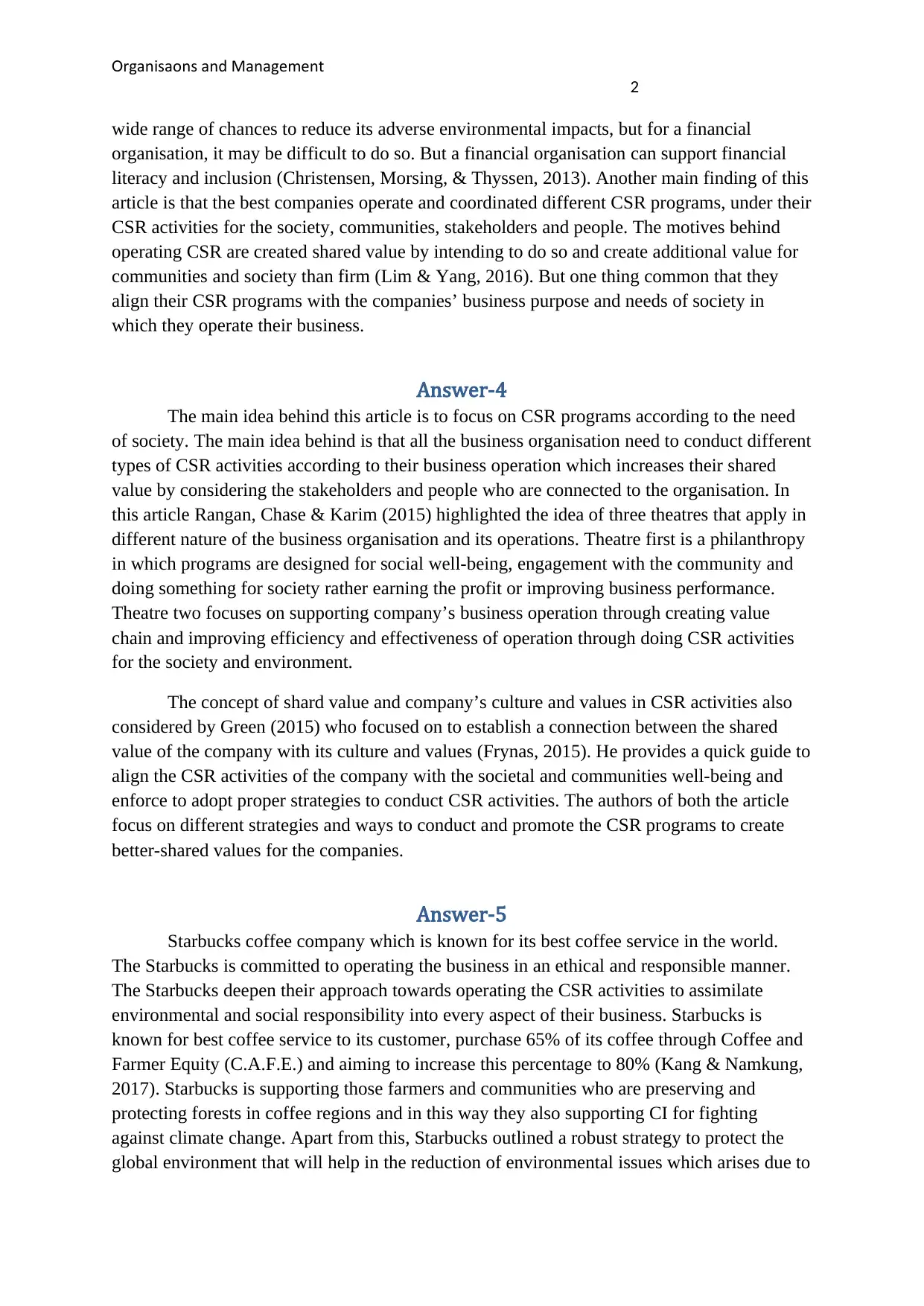
rganisations and ManagementO
2
wide range of chances to reduce its adverse environmental impacts, but for a financial
organisation, it may be difficult to do so. But a financial organisation can support financial
literacy and inclusion (Christensen, Morsing, & Thyssen, 2013). Another main finding of this
article is that the best companies operate and coordinated different CSR programs, under their
CSR activities for the society, communities, stakeholders and people. The motives behind
operating CSR are created shared value by intending to do so and create additional value for
communities and society than firm (Lim & Yang, 2016). But one thing common that they
align their CSR programs with the companies’ business purpose and needs of society in
which they operate their business.
Answer-4
The main idea behind this article is to focus on CSR programs according to the need
of society. The main idea behind is that all the business organisation need to conduct different
types of CSR activities according to their business operation which increases their shared
value by considering the stakeholders and people who are connected to the organisation. In
this article Rangan, Chase & Karim (2015) highlighted the idea of three theatres that apply in
different nature of the business organisation and its operations. Theatre first is a philanthropy
in which programs are designed for social well-being, engagement with the community and
doing something for society rather earning the profit or improving business performance.
Theatre two focuses on supporting company’s business operation through creating value
chain and improving efficiency and effectiveness of operation through doing CSR activities
for the society and environment.
The concept of shard value and company’s culture and values in CSR activities also
considered by Green (2015) who focused on to establish a connection between the shared
value of the company with its culture and values (Frynas, 2015). He provides a quick guide to
align the CSR activities of the company with the societal and communities well-being and
enforce to adopt proper strategies to conduct CSR activities. The authors of both the article
focus on different strategies and ways to conduct and promote the CSR programs to create
better-shared values for the companies.
Answer-5
Starbucks coffee company which is known for its best coffee service in the world.
The Starbucks is committed to operating the business in an ethical and responsible manner.
The Starbucks deepen their approach towards operating the CSR activities to assimilate
environmental and social responsibility into every aspect of their business. Starbucks is
known for best coffee service to its customer, purchase 65% of its coffee through Coffee and
Farmer Equity (C.A.F.E.) and aiming to increase this percentage to 80% (Kang & Namkung,
2017). Starbucks is supporting those farmers and communities who are preserving and
protecting forests in coffee regions and in this way they also supporting CI for fighting
against climate change. Apart from this, Starbucks outlined a robust strategy to protect the
global environment that will help in the reduction of environmental issues which arises due to
2
wide range of chances to reduce its adverse environmental impacts, but for a financial
organisation, it may be difficult to do so. But a financial organisation can support financial
literacy and inclusion (Christensen, Morsing, & Thyssen, 2013). Another main finding of this
article is that the best companies operate and coordinated different CSR programs, under their
CSR activities for the society, communities, stakeholders and people. The motives behind
operating CSR are created shared value by intending to do so and create additional value for
communities and society than firm (Lim & Yang, 2016). But one thing common that they
align their CSR programs with the companies’ business purpose and needs of society in
which they operate their business.
Answer-4
The main idea behind this article is to focus on CSR programs according to the need
of society. The main idea behind is that all the business organisation need to conduct different
types of CSR activities according to their business operation which increases their shared
value by considering the stakeholders and people who are connected to the organisation. In
this article Rangan, Chase & Karim (2015) highlighted the idea of three theatres that apply in
different nature of the business organisation and its operations. Theatre first is a philanthropy
in which programs are designed for social well-being, engagement with the community and
doing something for society rather earning the profit or improving business performance.
Theatre two focuses on supporting company’s business operation through creating value
chain and improving efficiency and effectiveness of operation through doing CSR activities
for the society and environment.
The concept of shard value and company’s culture and values in CSR activities also
considered by Green (2015) who focused on to establish a connection between the shared
value of the company with its culture and values (Frynas, 2015). He provides a quick guide to
align the CSR activities of the company with the societal and communities well-being and
enforce to adopt proper strategies to conduct CSR activities. The authors of both the article
focus on different strategies and ways to conduct and promote the CSR programs to create
better-shared values for the companies.
Answer-5
Starbucks coffee company which is known for its best coffee service in the world.
The Starbucks is committed to operating the business in an ethical and responsible manner.
The Starbucks deepen their approach towards operating the CSR activities to assimilate
environmental and social responsibility into every aspect of their business. Starbucks is
known for best coffee service to its customer, purchase 65% of its coffee through Coffee and
Farmer Equity (C.A.F.E.) and aiming to increase this percentage to 80% (Kang & Namkung,
2017). Starbucks is supporting those farmers and communities who are preserving and
protecting forests in coffee regions and in this way they also supporting CI for fighting
against climate change. Apart from this, Starbucks outlined a robust strategy to protect the
global environment that will help in the reduction of environmental issues which arises due to
⊘ This is a preview!⊘
Do you want full access?
Subscribe today to unlock all pages.

Trusted by 1+ million students worldwide
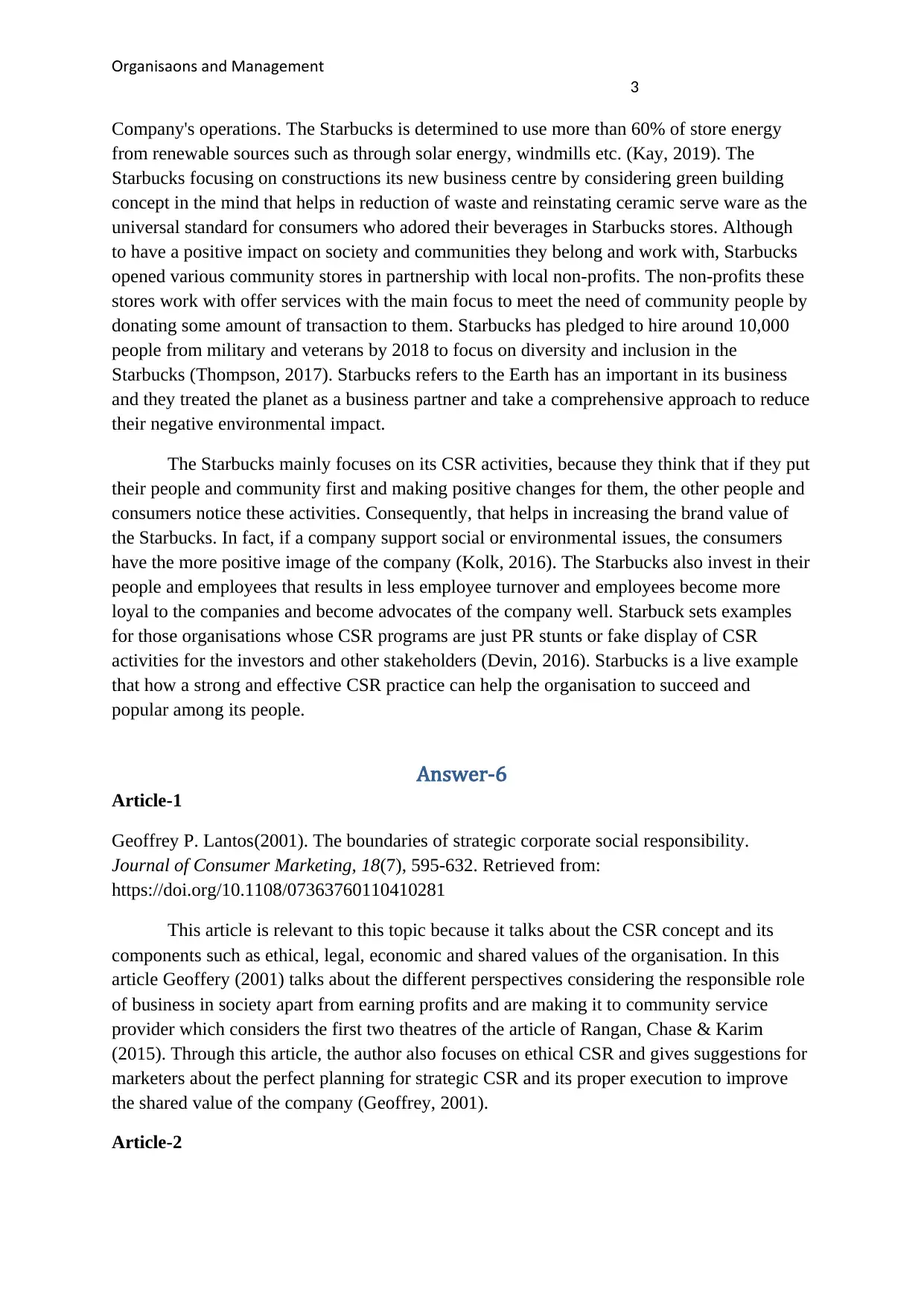
rganisations and ManagementO
3
Company's operations. The Starbucks is determined to use more than 60% of store energy
from renewable sources such as through solar energy, windmills etc. (Kay, 2019). The
Starbucks focusing on constructions its new business centre by considering green building
concept in the mind that helps in reduction of waste and reinstating ceramic serve ware as the
universal standard for consumers who adored their beverages in Starbucks stores. Although
to have a positive impact on society and communities they belong and work with, Starbucks
opened various community stores in partnership with local non-profits. The non-profits these
stores work with offer services with the main focus to meet the need of community people by
donating some amount of transaction to them. Starbucks has pledged to hire around 10,000
people from military and veterans by 2018 to focus on diversity and inclusion in the
Starbucks (Thompson, 2017). Starbucks refers to the Earth has an important in its business
and they treated the planet as a business partner and take a comprehensive approach to reduce
their negative environmental impact.
The Starbucks mainly focuses on its CSR activities, because they think that if they put
their people and community first and making positive changes for them, the other people and
consumers notice these activities. Consequently, that helps in increasing the brand value of
the Starbucks. In fact, if a company support social or environmental issues, the consumers
have the more positive image of the company (Kolk, 2016). The Starbucks also invest in their
people and employees that results in less employee turnover and employees become more
loyal to the companies and become advocates of the company well. Starbuck sets examples
for those organisations whose CSR programs are just PR stunts or fake display of CSR
activities for the investors and other stakeholders (Devin, 2016). Starbucks is a live example
that how a strong and effective CSR practice can help the organisation to succeed and
popular among its people.
Answer-6
Article-1
Geoffrey P. Lantos(2001). The boundaries of strategic corporate social responsibility.
Journal of Consumer Marketing, 18(7), 595-632. Retrieved from:
https://doi.org/10.1108/07363760110410281
This article is relevant to this topic because it talks about the CSR concept and its
components such as ethical, legal, economic and shared values of the organisation. In this
article Geoffery (2001) talks about the different perspectives considering the responsible role
of business in society apart from earning profits and are making it to community service
provider which considers the first two theatres of the article of Rangan, Chase & Karim
(2015). Through this article, the author also focuses on ethical CSR and gives suggestions for
marketers about the perfect planning for strategic CSR and its proper execution to improve
the shared value of the company (Geoffrey, 2001).
Article-2
3
Company's operations. The Starbucks is determined to use more than 60% of store energy
from renewable sources such as through solar energy, windmills etc. (Kay, 2019). The
Starbucks focusing on constructions its new business centre by considering green building
concept in the mind that helps in reduction of waste and reinstating ceramic serve ware as the
universal standard for consumers who adored their beverages in Starbucks stores. Although
to have a positive impact on society and communities they belong and work with, Starbucks
opened various community stores in partnership with local non-profits. The non-profits these
stores work with offer services with the main focus to meet the need of community people by
donating some amount of transaction to them. Starbucks has pledged to hire around 10,000
people from military and veterans by 2018 to focus on diversity and inclusion in the
Starbucks (Thompson, 2017). Starbucks refers to the Earth has an important in its business
and they treated the planet as a business partner and take a comprehensive approach to reduce
their negative environmental impact.
The Starbucks mainly focuses on its CSR activities, because they think that if they put
their people and community first and making positive changes for them, the other people and
consumers notice these activities. Consequently, that helps in increasing the brand value of
the Starbucks. In fact, if a company support social or environmental issues, the consumers
have the more positive image of the company (Kolk, 2016). The Starbucks also invest in their
people and employees that results in less employee turnover and employees become more
loyal to the companies and become advocates of the company well. Starbuck sets examples
for those organisations whose CSR programs are just PR stunts or fake display of CSR
activities for the investors and other stakeholders (Devin, 2016). Starbucks is a live example
that how a strong and effective CSR practice can help the organisation to succeed and
popular among its people.
Answer-6
Article-1
Geoffrey P. Lantos(2001). The boundaries of strategic corporate social responsibility.
Journal of Consumer Marketing, 18(7), 595-632. Retrieved from:
https://doi.org/10.1108/07363760110410281
This article is relevant to this topic because it talks about the CSR concept and its
components such as ethical, legal, economic and shared values of the organisation. In this
article Geoffery (2001) talks about the different perspectives considering the responsible role
of business in society apart from earning profits and are making it to community service
provider which considers the first two theatres of the article of Rangan, Chase & Karim
(2015). Through this article, the author also focuses on ethical CSR and gives suggestions for
marketers about the perfect planning for strategic CSR and its proper execution to improve
the shared value of the company (Geoffrey, 2001).
Article-2
Paraphrase This Document
Need a fresh take? Get an instant paraphrase of this document with our AI Paraphraser
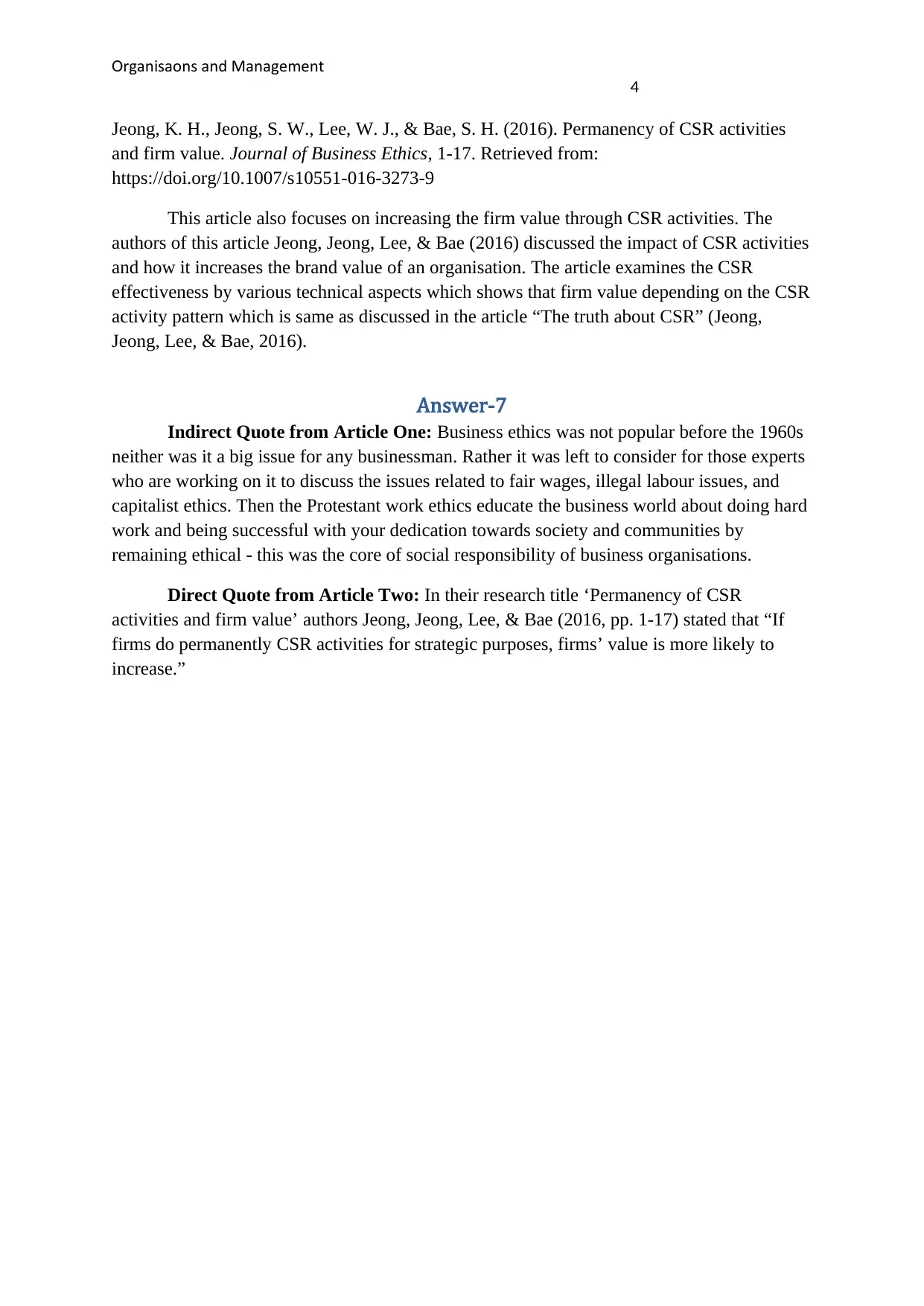
rganisations and ManagementO
4
Jeong, K. H., Jeong, S. W., Lee, W. J., & Bae, S. H. (2016). Permanency of CSR activities
and firm value. Journal of Business Ethics, 1-17. Retrieved from:
https://doi.org/10.1007/s10551-016-3273-9
This article also focuses on increasing the firm value through CSR activities. The
authors of this article Jeong, Jeong, Lee, & Bae (2016) discussed the impact of CSR activities
and how it increases the brand value of an organisation. The article examines the CSR
effectiveness by various technical aspects which shows that firm value depending on the CSR
activity pattern which is same as discussed in the article “The truth about CSR” (Jeong,
Jeong, Lee, & Bae, 2016).
Answer-7
Indirect Quote from Article One: Business ethics was not popular before the 1960s
neither was it a big issue for any businessman. Rather it was left to consider for those experts
who are working on it to discuss the issues related to fair wages, illegal labour issues, and
capitalist ethics. Then the Protestant work ethics educate the business world about doing hard
work and being successful with your dedication towards society and communities by
remaining ethical - this was the core of social responsibility of business organisations.
Direct Quote from Article Two: In their research title ‘Permanency of CSR
activities and firm value’ authors Jeong, Jeong, Lee, & Bae (2016, pp. 1-17) stated that “If
firms do permanently CSR activities for strategic purposes, firms’ value is more likely to
increase.”
4
Jeong, K. H., Jeong, S. W., Lee, W. J., & Bae, S. H. (2016). Permanency of CSR activities
and firm value. Journal of Business Ethics, 1-17. Retrieved from:
https://doi.org/10.1007/s10551-016-3273-9
This article also focuses on increasing the firm value through CSR activities. The
authors of this article Jeong, Jeong, Lee, & Bae (2016) discussed the impact of CSR activities
and how it increases the brand value of an organisation. The article examines the CSR
effectiveness by various technical aspects which shows that firm value depending on the CSR
activity pattern which is same as discussed in the article “The truth about CSR” (Jeong,
Jeong, Lee, & Bae, 2016).
Answer-7
Indirect Quote from Article One: Business ethics was not popular before the 1960s
neither was it a big issue for any businessman. Rather it was left to consider for those experts
who are working on it to discuss the issues related to fair wages, illegal labour issues, and
capitalist ethics. Then the Protestant work ethics educate the business world about doing hard
work and being successful with your dedication towards society and communities by
remaining ethical - this was the core of social responsibility of business organisations.
Direct Quote from Article Two: In their research title ‘Permanency of CSR
activities and firm value’ authors Jeong, Jeong, Lee, & Bae (2016, pp. 1-17) stated that “If
firms do permanently CSR activities for strategic purposes, firms’ value is more likely to
increase.”
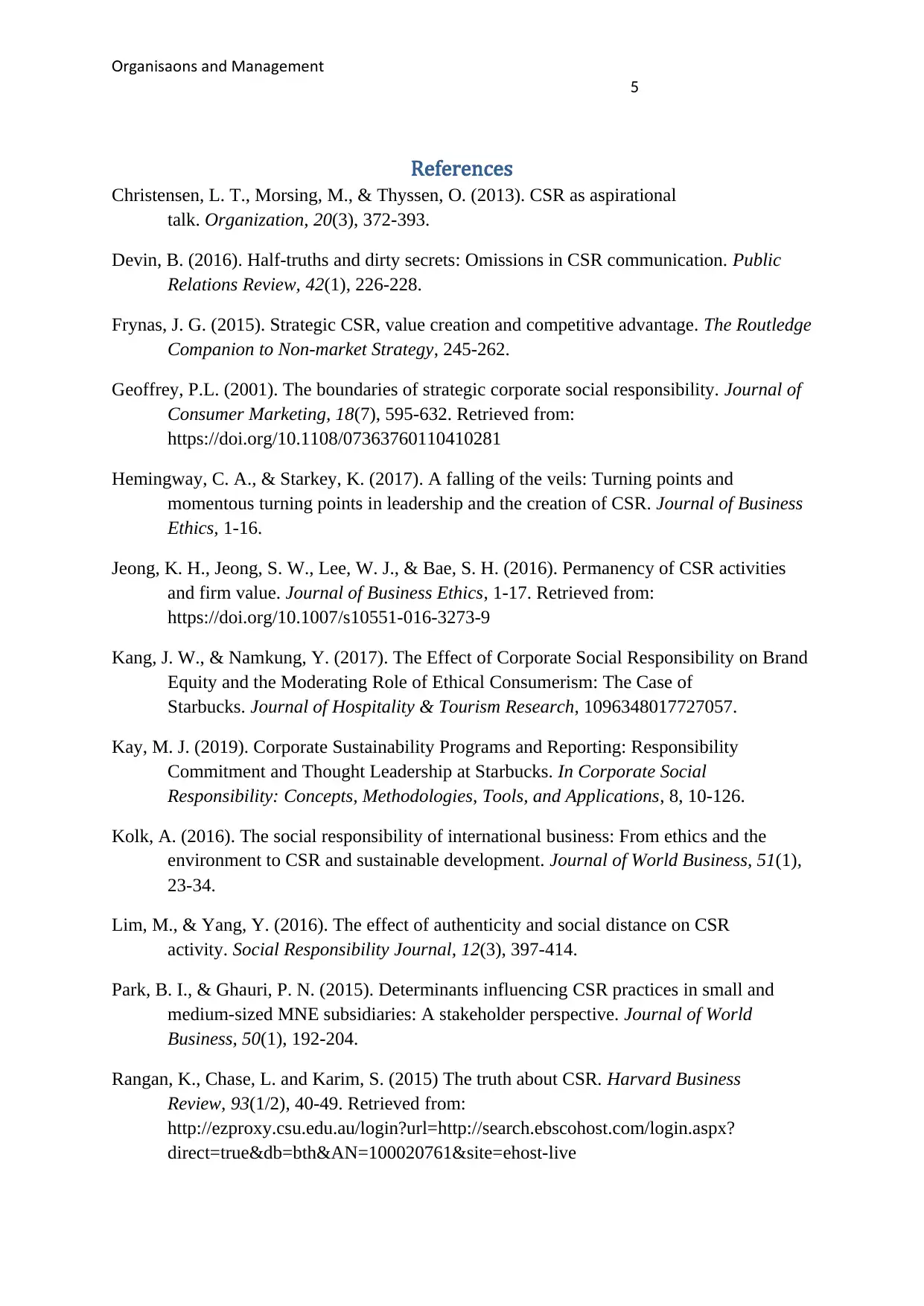
rganisations and ManagementO
5
References
Christensen, L. T., Morsing, M., & Thyssen, O. (2013). CSR as aspirational
talk. Organization, 20(3), 372-393.
Devin, B. (2016). Half-truths and dirty secrets: Omissions in CSR communication. Public
Relations Review, 42(1), 226-228.
Frynas, J. G. (2015). Strategic CSR, value creation and competitive advantage. The Routledge
Companion to Non-market Strategy, 245-262.
Geoffrey, P.L. (2001). The boundaries of strategic corporate social responsibility. Journal of
Consumer Marketing, 18(7), 595-632. Retrieved from:
https://doi.org/10.1108/07363760110410281
Hemingway, C. A., & Starkey, K. (2017). A falling of the veils: Turning points and
momentous turning points in leadership and the creation of CSR. Journal of Business
Ethics, 1-16.
Jeong, K. H., Jeong, S. W., Lee, W. J., & Bae, S. H. (2016). Permanency of CSR activities
and firm value. Journal of Business Ethics, 1-17. Retrieved from:
https://doi.org/10.1007/s10551-016-3273-9
Kang, J. W., & Namkung, Y. (2017). The Effect of Corporate Social Responsibility on Brand
Equity and the Moderating Role of Ethical Consumerism: The Case of
Starbucks. Journal of Hospitality & Tourism Research, 1096348017727057.
Kay, M. J. (2019). Corporate Sustainability Programs and Reporting: Responsibility
Commitment and Thought Leadership at Starbucks. In Corporate Social
Responsibility: Concepts, Methodologies, Tools, and Applications, 8, 10-126.
Kolk, A. (2016). The social responsibility of international business: From ethics and the
environment to CSR and sustainable development. Journal of World Business, 51(1),
23-34.
Lim, M., & Yang, Y. (2016). The effect of authenticity and social distance on CSR
activity. Social Responsibility Journal, 12(3), 397-414.
Park, B. I., & Ghauri, P. N. (2015). Determinants influencing CSR practices in small and
medium-sized MNE subsidiaries: A stakeholder perspective. Journal of World
Business, 50(1), 192-204.
Rangan, K., Chase, L. and Karim, S. (2015) The truth about CSR. Harvard Business
Review, 93(1/2), 40-49. Retrieved from:
http://ezproxy.csu.edu.au/login?url=http://search.ebscohost.com/login.aspx?
direct=true&db=bth&AN=100020761&site=ehost-live
5
References
Christensen, L. T., Morsing, M., & Thyssen, O. (2013). CSR as aspirational
talk. Organization, 20(3), 372-393.
Devin, B. (2016). Half-truths and dirty secrets: Omissions in CSR communication. Public
Relations Review, 42(1), 226-228.
Frynas, J. G. (2015). Strategic CSR, value creation and competitive advantage. The Routledge
Companion to Non-market Strategy, 245-262.
Geoffrey, P.L. (2001). The boundaries of strategic corporate social responsibility. Journal of
Consumer Marketing, 18(7), 595-632. Retrieved from:
https://doi.org/10.1108/07363760110410281
Hemingway, C. A., & Starkey, K. (2017). A falling of the veils: Turning points and
momentous turning points in leadership and the creation of CSR. Journal of Business
Ethics, 1-16.
Jeong, K. H., Jeong, S. W., Lee, W. J., & Bae, S. H. (2016). Permanency of CSR activities
and firm value. Journal of Business Ethics, 1-17. Retrieved from:
https://doi.org/10.1007/s10551-016-3273-9
Kang, J. W., & Namkung, Y. (2017). The Effect of Corporate Social Responsibility on Brand
Equity and the Moderating Role of Ethical Consumerism: The Case of
Starbucks. Journal of Hospitality & Tourism Research, 1096348017727057.
Kay, M. J. (2019). Corporate Sustainability Programs and Reporting: Responsibility
Commitment and Thought Leadership at Starbucks. In Corporate Social
Responsibility: Concepts, Methodologies, Tools, and Applications, 8, 10-126.
Kolk, A. (2016). The social responsibility of international business: From ethics and the
environment to CSR and sustainable development. Journal of World Business, 51(1),
23-34.
Lim, M., & Yang, Y. (2016). The effect of authenticity and social distance on CSR
activity. Social Responsibility Journal, 12(3), 397-414.
Park, B. I., & Ghauri, P. N. (2015). Determinants influencing CSR practices in small and
medium-sized MNE subsidiaries: A stakeholder perspective. Journal of World
Business, 50(1), 192-204.
Rangan, K., Chase, L. and Karim, S. (2015) The truth about CSR. Harvard Business
Review, 93(1/2), 40-49. Retrieved from:
http://ezproxy.csu.edu.au/login?url=http://search.ebscohost.com/login.aspx?
direct=true&db=bth&AN=100020761&site=ehost-live
⊘ This is a preview!⊘
Do you want full access?
Subscribe today to unlock all pages.

Trusted by 1+ million students worldwide
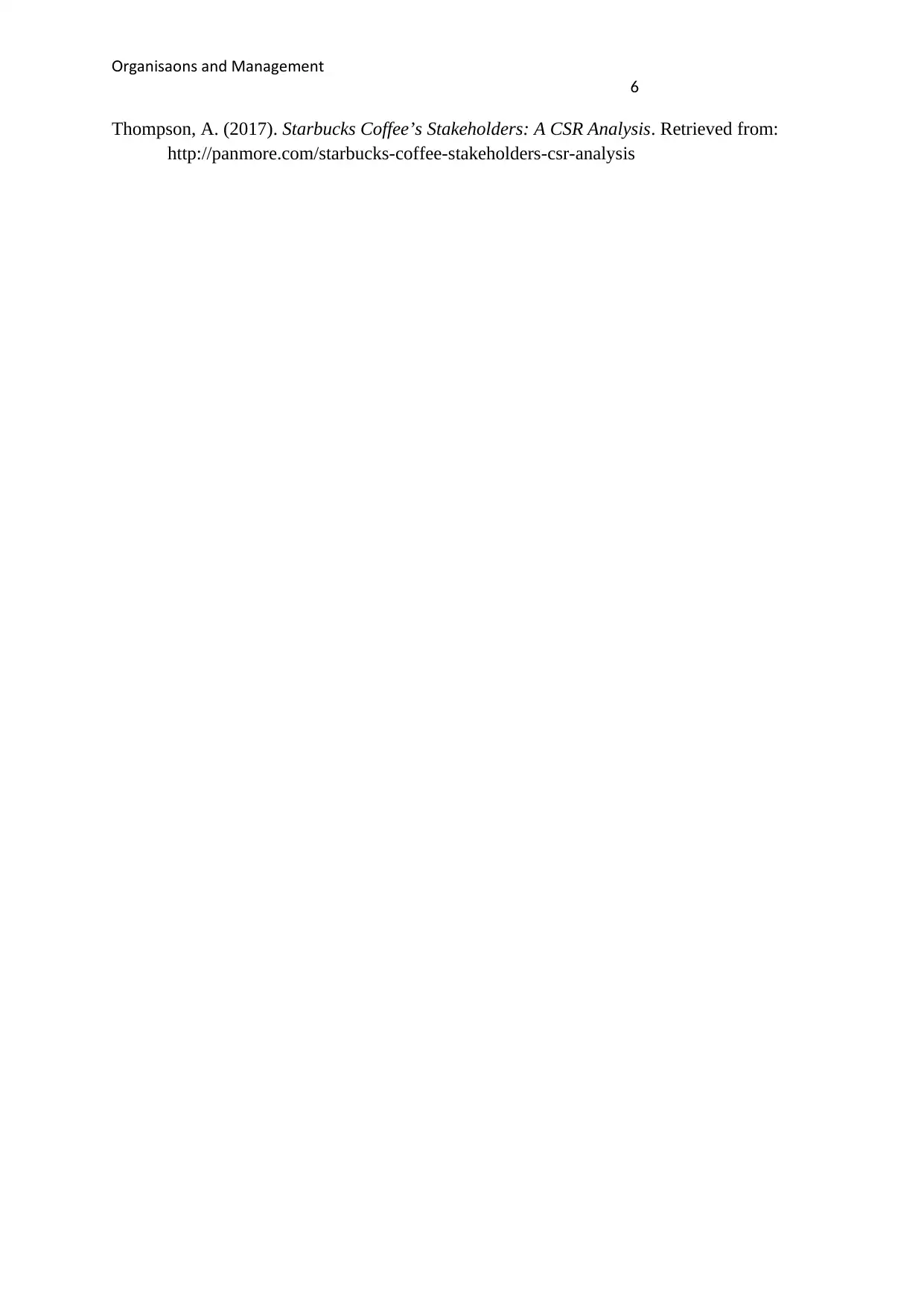
rganisations and ManagementO
6
Thompson, A. (2017). Starbucks Coffee’s Stakeholders: A CSR Analysis. Retrieved from:
http://panmore.com/starbucks-coffee-stakeholders-csr-analysis
6
Thompson, A. (2017). Starbucks Coffee’s Stakeholders: A CSR Analysis. Retrieved from:
http://panmore.com/starbucks-coffee-stakeholders-csr-analysis
1 out of 7
Related Documents
Your All-in-One AI-Powered Toolkit for Academic Success.
+13062052269
info@desklib.com
Available 24*7 on WhatsApp / Email
![[object Object]](/_next/static/media/star-bottom.7253800d.svg)
Unlock your academic potential
Copyright © 2020–2025 A2Z Services. All Rights Reserved. Developed and managed by ZUCOL.





